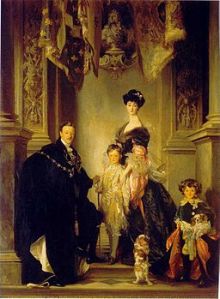When Consuelo Vanderbilt did her duty and produced the required “heir and a spare” for the 9th Duke of Marlborough, she rocked her boys in a regal cradle, which is still on view at Blenheim Palace. Consuelo’s mother, the irrepressible Alva Vanderbilt, wasted no time in ordering this cradle from Italy. She had moved heaven and earth to marry her very rich daughter to the Duke of Marlborough. The birth of a male heir insured that the Vanderbilt bloodline would forever have a secure footing in the British aristocracy.
According to a placard about the cradle in Blenheim Palace, it was a near-replica of the one made for Napoleon Bonaparte’s long-awaited heir in 1811. I don’t see much resemblance, though. Consuelo’s cradle is ornate, over-the-top with fanciful figures and gilding. (Actually, a baby being rocked in this cradle would have gone straight over the top and onto the floor–the mattress is even with the sides. If Consuelo actually used it, she must have used it with a lower mattress).
Napoleon II’s cradle is now in the Imperial Treasury in Vienna, because the child’s mother was Napoleon’s second wife, Marie-Louise of Austria. It was never actually subjected to a burping, crying child. It was a ceremonial object–a “throne cradle”– presented to Empress Marie Louise by the City of Paris. This cradle has a distinctly military look. It was fashioned of 280 kg of silver, replete with symbols of power and good government: horns of plenty, the Roman Capitoline Wolf, a laurel wreath, a crown of stars, and numerous bees. Napoleon the Emperor took the bee as his personal emblem; it was also an old symbol of Paris, indicating diligence. The foot of the cradle has a small eagle; Napoleon II was popularly known as “The Eaglet,” with the hope that he would surpass even the glorious exploits of his father.
Napoleon’s only legitimate son had a short and tragic life. The Emperor made his son the King of Rome the instant he was born. Glory did not follow, though. After his father’s abdication in 1814, Napoleon II’s mother was forced to flee home to Austria with her toddler. She remained married to Napoleon, but never saw him again. The child died in isolation in Austria, where he had to be kept from the public for fear of his father’s admirers trying to rally around him. I read somewhere that the unfortunate child’s only companion was a pet bird. He was a frail, sickly child, kept indoors almost all the time. He died of tuberculosis at age 21.
Consuelo’s marriage to the 9th Duke of Marlborough was loveless and unhappy, but her older son, in the fullness of time, became the 10th Duke of Marlborough and her younger son lived out his days as Lord Ivor Spencer-Churchill. Consuelo’s ancestors continue to occupy Blenheim Palace to this day.
Join me next time for more explorations in the art and history of Europe and the British Isles!





